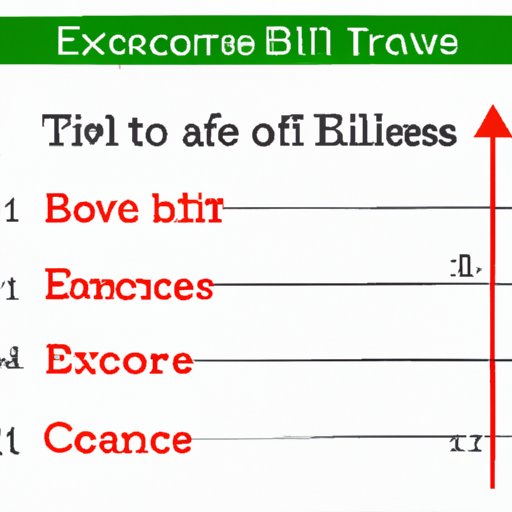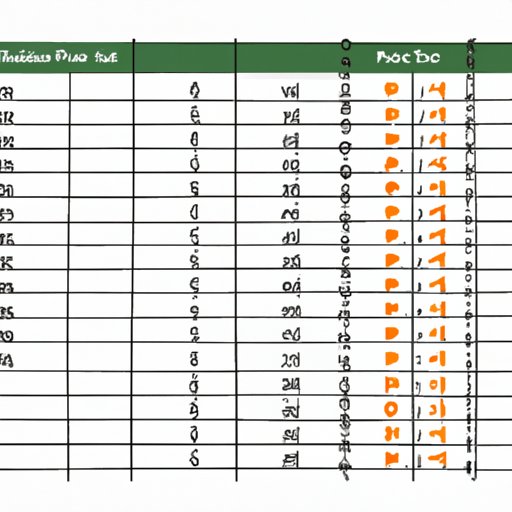The Ultimate Guide to Deleting Blank Rows in Excel
Are you tired of dealing with blank rows in your Excel spreadsheets? They can be an eyesore, make your data set difficult to navigate, and even cause errors in your calculations. Fortunately, removing them doesn’t have to be a daunting task. In this article, we’ll provide you with a step-by-step guide on how to delete blank rows in Excel. We’ll also discuss different techniques and offer tips and tricks for beginners and professionals alike.
Step-by-Step Guide to Removing Blank Rows in Excel
Before we dive into the details of removing blank rows in Excel, let’s first discuss the basics. To remove a blank row, you’ll need to select the entire row by clicking on the row number on the left-hand side of the spreadsheet. Once selected, you can either use the ‘delete’ key on your keyboard or right-click and select ‘delete’.
To make this process easier, you can use the ‘Go To Special’ function in Excel. This function scans your spreadsheet for specific types of cells, including blank ones. Here’s how to use it:
- Select the range of cells you want to search for blank rows.
- Click on the ‘Find & Select’ button in the ‘Editing’ group of the ‘Home’ tab.
- Select ‘Go To Special’ from the drop-down menu.
- Select ‘Blanks’ and click ‘OK.’
- All the blank cells in the selected range will be highlighted. You can now follow the same steps as before to delete the rows.
For visual learners, here’s a screenshot of the ‘Go To Special’ menu:

It’s important to note that deleting a row will also delete any data in that row, so be sure to save your work before proceeding.
If you accidentally delete a row and need to retrieve it, you can use the ‘undo’ function with the keyboard shortcut ‘Ctrl + Z’ or by clicking on the ‘Undo’ button in the ‘Quick Access Toolbar.’
Now that you have a basic understanding of how to remove blank rows, let’s dive into some more advanced techniques.
How to Get Rid of Unnecessary Rows in Excel: 5 Easy Ways to Delete Blank Cells and Optimize Your Data Set
There’s more than one way to remove blank rows from your Excel spreadsheet. Here are five techniques to help you do so:
- Sort your data by a specific column: This will bring all the blank rows to the top or bottom of your spreadsheet, making them easier to identify and remove.
- Use the ‘Filter’ function: Similar to sorting, this will allow you to view only the blank rows in your spreadsheet.
- Use the ‘IF’ function: This function can be used to determine if a cell is empty and will return a specified value if it is. You can then filter or sort by this value to remove the blank rows.
- Use a macro: Macros can be helpful for large datasets that require repetitive tasks. You can record a macro that will automate the process of deleting blank rows.
- Use a third-party tool: There are several software programs available, such as Kutools for Excel and ASAP Utilities, that offer additional features and functionality for Excel users.
Remember, removing blank rows is just one step in optimizing your data set. Here are a few more tips on how to keep your data presentable and organized:
- Use clear and concise column headings.
- Avoid using cell colors for formatting.
- Ensure your data is aligned and consistent throughout the spreadsheet.
Quick and Easy Methods for Deleting Blank Rows in Large Excel Datasets
If you’re working with a large amount of data, the process of removing blank rows can be time-consuming. Here are some quick methods to help you:
- Use keyboard shortcuts: Keyboard shortcuts can save you time and effort. For example, you can use ‘Ctrl + Shift + Arrow’ to select an entire column or row.
- Use the ‘Conditional Formatting’ function: This function can be used to identify and highlight blank rows, making them easier to remove.
- Use Excel add-ins: There are several add-ins available, such as Ablebits or ASAP Utilities, that can automate the process of removing blank rows.
Additionally, to prevent future blank rows from appearing, try using data validation or protecting your worksheet.
Efficient Techniques to Remove Blank Rows in Excel: A Comprehensive Guide for Professionals
If you use Excel on a regular basis and work with complex data sets, you may need some more advanced techniques for removing blank rows. Here are a few to consider:
- Use Power Query: This tool allows you to connect to external data sources and remove blank rows before importing them into Excel.
- Use VBA code: This requires some programming knowledge, but it can be helpful for automating repetitive tasks.
- Use a pivot table: This will allow you to summarize your data and remove any unnecessary rows.
Be sure to save a backup copy of your spreadsheet before attempting any of these techniques, as they can be more complex and may cause errors if not executed properly.
Understanding the Most Effective Ways to Delete Blank Rows in Excel
Keeping your Excel spreadsheet organized and presentable is essential for maintaining accuracy and productivity. Here are a few key tips to keep in mind:
- Be consistent with your formatting.
- Use logical and clear headings and labels.
- Remove any unnecessary formatting, such as cell colors or borders.
When it comes to removing blank rows, be sure to take the time to understand the different techniques available and choose the one that is most appropriate for your data set. Avoid rushing through the process, as this can lead to errors and mistakes.

How to Save Time and Improve Accuracy with These Essential Excel Tips: Removing Blank Rows in Different Versions of Excel
It’s important to note that different versions of Excel may have slight variations in the blank row deletion process. Here are some tips to help you navigate different versions:
- For Excel 2010 and later versions: Use the ‘Go To Special’ function to highlight blank cells and then delete the rows.
- For Excel 2007 and earlier versions: Select the entire row by clicking on the row number, right-click and select ‘delete.’
- For Excel on Mac: Use the ‘Find and Replace’ function to replace all blank cells with a specified value, then filter or sort to remove the rows.
By keeping these tips in mind, you can optimize your workflow and improve your Excel skills.
Learn the Best Practices for Removing Blank Rows in Excel: Maximizing Your Spreadsheet Productivity with Ease
Now that you’ve learned about different techniques for removing blank rows in Excel, it’s time to put them into practice. By implementing these tips and tricks into your workflow, you can minimize errors, save time and improve accuracy.
Remember to review your spreadsheet before sharing it with others or using it for calculations to ensure it is accurate and presentable.
Conclusion
Blank rows in Excel can be frustrating, but with the techniques discussed in this article, you can easily remove them and optimize your data set. Remember to choose the technique that is most appropriate for your data set and take the time to ensure your spreadsheet is organized and accurate.
By following the tips and tricks discussed in this article, you can improve your Excel skills, save time and increase your productivity.
